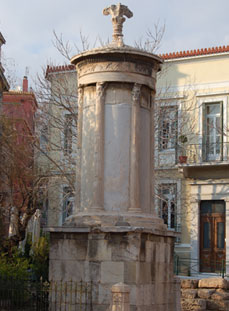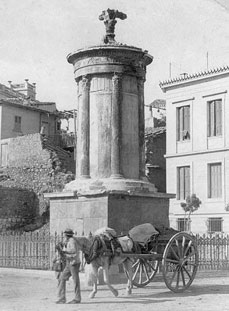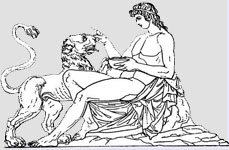


Athens Lysicrates Monument
This monument is located on north side of Plaka Square at the junction of Selley and Epimenidou street. One can descend into the excavations that surround the choregic monument, which is the only to have survived more or less intact from the late Classical period.
According to the inscription on the monument, it was built in 335/4 BC by, Lysicrates of Kikina, the son of Lysitheides, was choregos, tribe of Akamantis won the victory with the choros of boys; Theon played the flute; Lysiades of Athens trained the choros; Euainetos was archon".
The monument consists of a square base of Piraeus limestone, 4 m high, with a cornice of Eleusinian marble. On this rests a three-stepped krepis of Hymettan marble. The entire superstructure is of Pentelic marble. On the stylobate stand six monolithic columns with Corinthian capitals. This is the first known external use of the Corinthian capital in Greek architecture. The central cylinder or drum has curved panels of Hymettian marble, engaged to the columns. At the top of each panel are two tripods carved in relief. Three of the six columns were removed between 1669 and 1821. Most scholars believe hat the interior of the drum was never, intended to be seen, as the capitals are unfinished. H. Bauer (German Archaeological Institute), however, argues that it was not, in fact, a closed tower but originally meant to be open with a statue visible inside, of Dionysos? The entablature includes a relief frieze depicting the story of Dionysos (son of Zeus and Semele, the daughter of Kadmos, King of Thebes) and the Tyrrhenian pirates who failed to recognize him as a god. A seated, victorious Dionysos with his drinking cup, surrounded by satyrs, transforms into dolphins the pirates who had kidnapped him (as recounted in the subject of the second Homeric Hymn to Dionysos). The content of Lysiades' dithyrambos (a form of lyric poetry in honor of Dionysos) may have been the same as the subject of the frieze. On the architrave below is the dedicatory inscription with the name of the victorious choregos and his tribe, carved directly below the figure of Dionysos. The entablature was crowned by a marble dome carved delicately from a single block of marble with a relief imbricate laurel leaf pattern on its surface. From the apex of the dome rises an elaborate finial (akroterion), consisting of huge, elaborate akanthos leaves and stem, which once supported the large bronze tripod of victory according to Bauer. Other scholars, such as Pierre Amandry (French School of Archaeology), believe that this akroterion just supported the tripod's cauldron with its legs around it. James McCredie (Institute of Fine Arts, New York University) sees many influences from Macedonian royal architecture. This and the other elaborate contemporaneous choregic monuments were probably linked to the reinvigoration of civic pride, stimulated by the policies and activities of Lykourgos in the 330s and 320s BC. At least as early as 1460 the choregic monument of Lysikrates was known popularly as the Lantern of Demosthenes because people believed erroneously that this mid-4th century BC Athenian orator prepared his speeches there. Before 1658 it was part of a monastery. Then, between 1669 and 1821 this monument was incorporated into the library of a French Capuchin monastery. European travelers making the Grand Tour often lodged here. Lord Byron supposedly used it as his study during his sojourn at the monastery and wrote part of Childe Harold's Pilgrimage here in 1810-1811.
During the occupation of Athens by Omer Vrionis in 1821 the convent burnt down accidentally, thus, freeing the monument. Lord Elgin afterwards tried unsuccessfully to dismantle it from the ruins of the abandoned monastery and ship the stones to England. The monument was restored in 1845 and 1892, with French funding.
